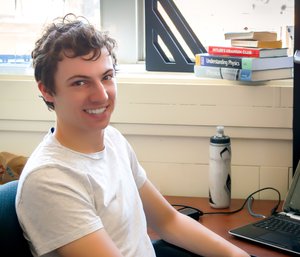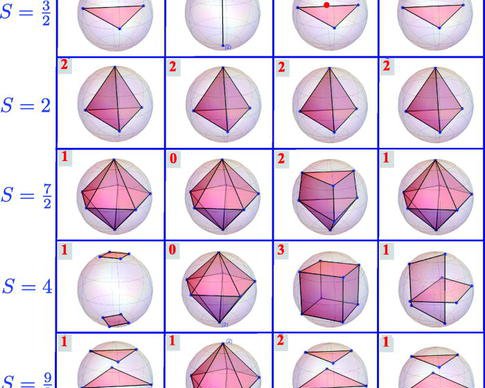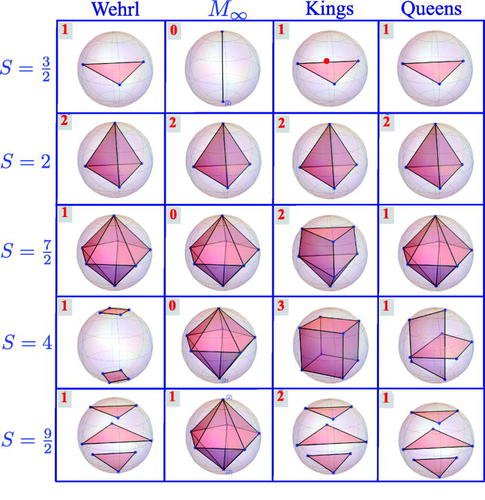Just how 'quantum' is it? Physicist Aaron Goldberg has an answer - Chris Sasaki, Arts & Science News.
This article was published in Arts and Science News on January 22, 2021.
It is followed by an interview with U of T Physics’ graduate student Aaron Goldberg by Sheela Manek from Interactions.

A team of physicists have taken a step toward answering a decades-old question: just how quantum is something? The collaborators have developed a way to mathematically describe the “quantumness” of different objects or systems — that is, the degree to which they behave in a quantum manner.
Aaron Goldberg is a PhD candidate in the Faculty of Arts & Science’s Department of Physics and lead author of the paper published in the journal AVS Quantum Science describing the finding.
“Previously, researchers had measured quantumness in systems that involved light,” says Goldberg. “But we can apply our generalized approach to any quantum system — systems involving light, atoms, molecules or even combinations of those things.” The subatomic world described by quantum physics is very different from the world described by Newton’s classical laws of physics.
In the familiar world of classical physics, we know the position and momentum of objects with enough precision to, for example, make a difficult shot in a game of billiards. We also know the ball won’t magically transform into something other than a ball. It won’t inexplicably pass through the side of the table. And we know when we strike a ball on our table, it won’t affect a ball on another table on the other side of the planet. But in the quantum world, a subatomic particle — unlike a billiard ball on a pool table — has only a probable position and speed. Light acts sometimes like particles and sometimes like waves. Subatomic particles can quantum tunnel through seemingly impenetrable barriers. And particles can mirror each other over vast distances — a phenomenon known as quantum entanglement.
These characteristics define an object’s quantumness.
According to Goldberg, when quantum theory was first formulated, many believed there was a clear distinction between the classical and quantum — that objects were one or the other. But as our understanding of the quantum realm grew, that idea changed.
“Over the years, scientists conducted more and more sophisticated experiments but failed to see a distinct boundary between the two,” says Goldberg. “And now, the prevailing theory is that quantum mechanics describes everything from photons to billiard balls to planets.
“In fact, there are probably an infinite number of degrees of quantumness.” For example, a billiard ball is in fact a quantum object that could tunnel through the side of the table. But that would only happen if the quantum state of the atoms and molecules in the ball aligned — and the chances of that are as small as the number of atoms and molecules in the ball is large.
Goldberg and his collaborators looked at the quantum end of the classical to quantum spectrum and identified the two highest degrees of quantumness which they labeled as “King” and “Queen.”
“And there are definitely more than just Kings and Queens,” says Goldberg. While the research seems esoteric, there are important applications in our increasingly quantum world.
Knowledge about the degree of quantumness of a system may help in the development of quantum computers, sensing technologies and in the technologies used to measure physical constants and other properties with extreme precision. For example, this research could potentially help in detecting gravitational waves because those observations involve measurements that must be accurate to 1/10,000th the diameter of a proton.
Goldberg and his colleagues are continuing to explore extreme quantum states with the help of teams in labs around the world — including that of Aephraim Steinberg, a professor in the Department of Physics.
“This result feels like a single step down a long road,” says Goldberg. “I think research like this into extreme quantum states has just begun. I expect I’ll be revisiting this quest for a good while.”
Read the U of T Arts and Science News article here:
https://www.artsci.utoronto.ca/news/just-how-quantum-it-physicist-aaron-goldberg-has-answer


(Image: Majorana representation for states that maximize the Wehrl entropy and maximize M∞, which are Kings of Quantumness and Queens of Quantumness. In each row, we indicate the value of S. In the top-left corner of each cell, we indicate (in red) the corresponding degree of unpolarization. The degeneracies at some points of the constellations are indicated in blue.)
Hi Aaron, welcome to Interactions. Can you tell me a little about yourself?
Glad to be here! I did my undergrad in Integrated Science down the road at McMaster. Now I’m pursuing my PhD in quantum optics with Professor Daniel James, looking to use quantum properties of light for enhanced quantum sensing. This seems to be one of the main areas in which quantum technology will have the earliest impact. Outside of research, I think I may hold the record for the number of people in the Department against whom I’ve played squash.
What made you interested in studying quantum mechanics?
I got into quantum through philosophical discussions with friends in high school. We discovered that moot philosophical questions could become empirical through quantum mechanics, we started learning, and the snowball has rolled from there.
This work is getting quite a bit of publicity. Can you tell me what that means to you?
Honestly, I think the biggest lesson is that fame begets fame. We thought this work might be interesting to the research community, but never expected popular science websites to pick it up. This is a cool opportunity for me to expose my research to non-experts and to be nicely surprised by comments on our work from complete strangers.
Can you tell me a little about the team that worked on this project with you?
This work was done during a visit to the Max Planck Institute for the Science of Light in Erlangen, Germany, hosted by Professors Luis Sánchez-Soto and Gerd Leuchs. I was lucky to be part of a dynamic collaboration there – we had experts on group theory, computational physics, and experimental quantum optics all working on various aspects of the project. The team had been working on various related projects for many years, so I feel fortunate to have joined at a time when everything was starting to come together.
Where did the “King” and “Queen” analogy come from?
This nomenclature predates me. I presume that Queens of Quantumness were chosen for alliterative purposes and that Kings of Quantumness were chosen to outshine the former. I know that the Kings were initially referred to as “anticoherent states,” to which the founder of coherent states, Roy Glauber, was opposed. The story diverges from there: one branch says that the name Kings was dubbed because our collaborator in Spain has a king; the other branch says that a mispronunciation of the French word for king sounds like Roy. Either way, Kings of Quantumness still preserves some alliteration…
Can you give our readers some examples where they could see “quantumness” in their everyday lives?
The hard part about this question is seeing: there are lots of important items in our lives whose operating principles can only be described using quantum mechanics, from transistors to lasers to GPS. If you want to actually see quantumness, one of the most straightforward methods is to use a prism to sort the light coming from a fluorescent bulb by wavelength/colour; that only discrete colours show up demonstrates the quantumness of fluorescence. I would argue that the most quantum things are those that are hardest to see every day – that’s what makes them so esoteric.
What is next for Aaron Goldberg?
Next for me is a job at the National Research Council focusing on designing and implementing photonic quantum information protocols. We’ll hopefully be able to demonstrate some useful advantages in sensing and communications with quantum light.
The paper titled Extremal Quantum States was published on November 17, 2020 in AVS Quantum Science.
Read the full article in AVS Quantum Science here:
https://avs.scitation.org/doi/10.1116/5.0025819
Read the article in Live Science here:
https://www.livescience.com/quantifying-quantumness.html
Read the article in AIP Publishing here:
https://publishing.aip.org/publications/latest-content/quantifying-quantumness-a-mathematical-project-of-immense-beauty/

